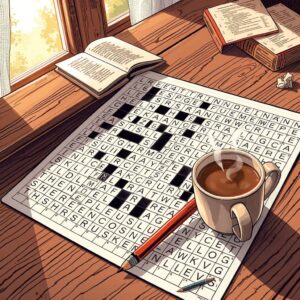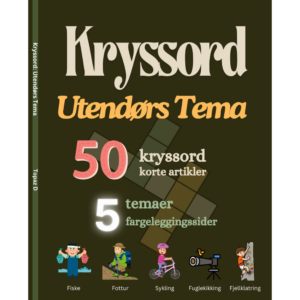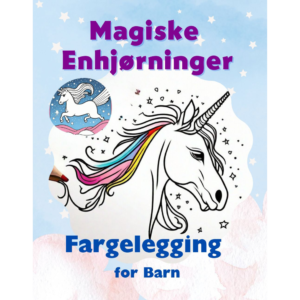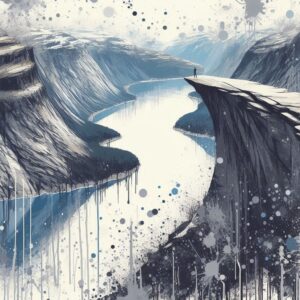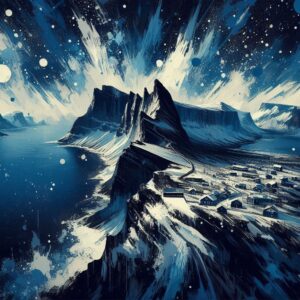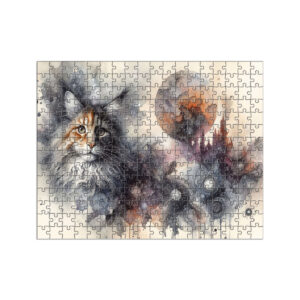
Explore & Play
Discover interesting topics and solve the accompanying crossword puzzle.
Norwegian Author Crossword Puzzle | Norway’s Literary Giants
Table of Contents
Welcome to our exploration of Norway’s literary heritage!
To make your journey through Norwegian literature both engaging and informative, we’ve designed a special “Norwegian Author Crossword” for you. Feel free to dive into the crossword puzzle first to test your knowledge of key Norwegian authors, or if you’re new to the topic, start with the article to gain some background and context. Once you’re familiar with the authors and their contributions, return to the crossword to challenge yourself further.
Enjoy the puzzle and the insights that follow!
Nowegian Author Crossword
You can either fill in the crossword puzzle directly on this page or click the button in the bottom right corner to print it for free.
Exploring Norway's Literary Heritage: Authors You Should Know
Norway, a land renowned for its breathtaking fjords and majestic landscapes, has also nurtured a rich literary tradition that has left an indelible mark on global literature. From the pioneering works of Henrik Ibsen to the modern narratives of Karl Ove Knausgård, Norwegian authors have explored the human condition, nature, and societal challenges with profound insight.
The Foundations of Norwegian Literature
The Birth of Modern Norwegian Literature
The roots of modern Norwegian literature can be traced back to the 19th century, a period that witnessed the rise of influential figures like Henrik Ibsen and Bjørnstjerne Bjørnson. These authors, among others, laid the foundation for a literary tradition that would explore the depths of human experience, national identity, and social issues.
Henrik Ibsen, often referred to as the “father of modern drama,” revolutionized theatre with his realistic portrayals of societal norms and personal struggles. His play A Doll’s House challenged traditional gender roles and sparked debates on the rights of women, making Ibsen a pivotal figure in the movement toward realism in literature.
Meanwhile, Bjørnstjerne Bjørnson not only contributed to Norwegian literature but also played a crucial role in the country’s national movement. His works, infused with patriotism and a deep love for Norwegian culture, earned him the Nobel Prize in Literature in 1903. Bjørnson’s contributions to poetry and drama, along with his involvement in politics, solidified his place as a national hero.
Another key figure from this era is Johan Sebastian Welhaven, a poet and critic who was instrumental in the Romantic movement in Norway. Welhaven’s poetry, often reflective of nature and the sublime, contrasted with the more nationalistic tone of his contemporaries, providing a richer, more nuanced view of Norwegian identity.
The Realist Movement
As the 19th century gave way to the 20th, Norwegian literature embraced realism, a movement that mirrored the social and political changes of the time. This period produced authors whose works depicted the realities of everyday life, often highlighting the struggles of the common people.
One of the most notable figures of this movement is Sigrid Undset, whose epic trilogy Kristin Lavransdatter earned her the Nobel Prize in 1928. Set in medieval Norway, the trilogy is celebrated for its meticulous historical detail and its exploration of faith, love, and identity. Undset’s portrayal of strong, complex female characters challenged the literary norms of her time and resonated with readers across generations.
Johan Bojer, another prominent realist, is best known for his novel The Great Hunger, which vividly depicts the hardships of rural Norwegian life. Bojer’s works often focus on the moral dilemmas faced by individuals in a rapidly changing society, making his novels both timeless and deeply relevant to contemporary readers.
Together, these authors laid the groundwork for a literary tradition that would continue to evolve and reflect the complexities of Norwegian society.
Literary Giants of the 20th Century
The Rise of Modernist and Experimental Writers
As the 20th century unfolded, Norwegian literature embraced modernism and experimental approaches, reflecting the complexities and uncertainties of modern life. This era brought forth a new generation of writers who pushed the boundaries of narrative structure and thematic exploration.
Tarjei Vesaas stands out as a central figure in this movement. His novel The Ice Palace is a haunting exploration of friendship, loss, and the natural world. Vesaas’s use of sparse, poetic language and his focus on the psychological inner worlds of his characters make his work a significant contribution to modernist literature.
Similarly, Kjartan Fløgstad became known for his innovative narrative techniques and his exploration of Norwegian identity in the context of industrialization and globalization. His novels often blend realism with elements of surrealism, creating a unique literary voice that has captivated readers both in Norway and abroad.
Jens Bjørneboe, a provocative and politically charged writer, also made his mark during this period. His works, which include Moment of Freedom and The History of Bestiality trilogy, challenge societal norms and critique the darker aspects of human nature. Bjørneboe’s fearless exploration of controversial topics has earned him a reputation as one of Norway’s most daring and influential authors.
The Influence of Feminism and Social Change
The latter half of the 20th century saw the emergence of powerful female voices in Norwegian literature. These authors not only challenged societal norms but also brought attention to issues of gender, sexuality, and identity through their works.
Gerd Brantenberg is best known for her satirical novel Egalia’s Daughters, which imagines a world where traditional gender roles are reversed. Through sharp wit and humor, Brantenberg critiques patriarchal structures and highlights the absurdities of gender inequality, making her a key figure in feminist literature.
Liv Ullmann, although primarily known as an actress, made significant contributions to literature through her memoirs and novels. Her writings, which often explore themes of love, loss, and identity, offer a deeply personal insight into the life of one of Norway’s most iconic cultural figures.
In the realm of psychological fiction, Hanne Ørstavik has garnered critical acclaim for her novels, such as Love, which delve into the complexities of human relationships and emotions. Ørstavik’s minimalist style and focus on the internal experiences of her characters make her a distinctive voice in contemporary Norwegian literature.
Contemporary Norwegian Literature
The Global Success of Norwegian Fiction
In recent decades, Norwegian literature has gained international acclaim, with authors breaking new ground and reaching global audiences. This success can be attributed to the unique perspectives and storytelling techniques that Norwegian writers bring to their work.
Jostein Gaarder achieved worldwide fame with his philosophical novel Sophie’s World, which introduces readers to the history of philosophy through the eyes of a young girl. The novel’s blend of fiction and philosophy has captivated millions of readers and has been translated into numerous languages, solidifying Gaarder’s place in the global literary landscape.
Equally impactful is Karl Ove Knausgård, whose autobiographical series My Struggle offers an unflinchingly honest account of his life, thoughts, and experiences. Knausgård’s willingness to expose his vulnerabilities and the minutiae of everyday life has resonated with readers around the world, making him one of the most influential contemporary authors.
Per Petterson, with his novel Out Stealing Horses, also reached an international audience. The novel, which explores themes of memory, loss, and the passage of time, has been praised for its lyrical prose and poignant storytelling. Petterson’s work continues to be celebrated for its deep emotional resonance and its exploration of the human condition.
The Thriving Genre of Crime Fiction
Norwegian crime fiction, often referred to as “Nordic noir,” has become a prominent genre, captivating readers with its dark, atmospheric narratives and complex characters. This genre has produced some of Norway’s most successful and widely read authors.
Karin Fossum is often dubbed the “Norwegian queen of crime” for her gripping detective novels featuring the introspective Inspector Sejer. Fossum’s ability to create suspenseful, psychologically rich narratives has earned her a devoted following both in Norway and internationally.
Håkan Nesser, though originally Swedish, has strong ties to Norwegian literature and has contributed significantly to the crime fiction genre. His novels, characterized by their intricate plots and deep psychological insight, have been translated into several languages, further popularizing Nordic noir.
Another noteworthy author in this genre is Åsa Larsson, who, like Nesser, straddles the Norwegian-Swedish literary divide. Larsson’s crime novels, known for their vivid descriptions of Scandinavian landscapes and their strong, complex female protagonists, have become bestsellers across Europe and beyond.
Thematic Exploration of Norwegian Literature
Nature and the Norwegian Landscape
The natural beauty of Norway’s landscapes has always been a profound influence on its literature, serving as both setting and symbol in many works. Norwegian authors have long drawn inspiration from the country’s rugged mountains, deep fjords, and expansive forests.
Tarjei Vesaas is a prime example of a writer whose work is deeply rooted in the natural world. In The Ice Palace, the stark, icy landscape becomes a character in its own right, reflecting the emotional turmoil of the protagonists. Vesaas’s ability to evoke the majesty and menace of nature has left a lasting impression on Norwegian literature.
In contemporary literature, Helga Flatland has been praised for her depiction of rural Norway, particularly in her novels about families and the bonds that tie them to the land. Flatland’s works often explore the tension between tradition and modernity, using the Norwegian landscape as a backdrop for her characters’ struggles and triumphs.
Edvard Hoem is another author who frequently incorporates elements of Norwegian nature into his historical novels. His works often depict the lives of Norwegian farmers and their relationship with the land, offering readers a glimpse into the country’s rural past and the enduring connection between people and place.
Identity and Cultural Reflection
Norwegian literature often grapples with questions of identity, reflecting the country’s historical and cultural evolution. This theme is particularly prominent in works that explore the intersection of personal and national identity.
Lars Saabye Christensen is one such author who delves into these themes. In his novel The Half Brother, Christensen explores the complexities of family, identity, and belonging in post-war Norway. The novel’s intricate narrative and richly drawn characters offer a deep reflection on the search for identity in a rapidly changing society.
Sverre Falk, though lesser-known internationally, has made significant contributions to Norwegian literature through his essays on cultural identity. Falk’s work often examines the ways in which Norwegian culture has been shaped by its history and geography, offering valuable insights into the national psyche.
Ingar Sletten Kolloen, a biographer and historian, has also explored themes of identity in his works. His biographies of prominent Norwegian figures, such as novelist Knut Hamsun, provide a nuanced understanding of how these individuals have influenced and been influenced by Norwegian culture.
Literary Criticism and Analysis
Norwegian Literary Criticism
Alongside the creation of literary works, Norwegian authors have also contributed significantly to literary criticism and theory. This aspect of Norwegian literature is essential for understanding how these works have been received and interpreted over time.
Sverre Årnes, a prolific writer and critic, has played a key role in shaping contemporary Norwegian literary criticism. His analyses of modern Norwegian literature, particularly in the realms of crime fiction and popular culture, have provided readers with deeper insights into the themes and trends that define the national literary landscape.
Similarly, Hildegard Behrens has made important contributions to the study of Norwegian literature, particularly through her work on gender and feminist theory. Behrens’s critical essays have shed light on the ways in which Norwegian literature has both reflected and challenged societal norms, making her an influential figure in the field of literary criticism.
The Role of Translation and Global Reach
The translation of Norwegian literature into other languages has played a vital role in its global reach and appreciation. Through translation, the works of Norwegian authors have found new audiences and have influenced literary traditions far beyond Norway’s borders.
Anna Funder, an Australian author and translator, has contributed to this process by making Norwegian literature more accessible to English-speaking readers. Her translations and adaptations have helped to bring the works of Norwegian authors to a wider audience, allowing readers around the world to experience the richness of Norwegian storytelling.
Benedictus H. Hegg has also played a crucial role in preserving and translating Norwegian folklore and literary works. His efforts have ensured that the stories and traditions of Norway are passed down to future generations, both within the country and beyond its borders.
Embracing the Rich Tapestry of Norwegian Literature
Norwegian literature, rich in history and diversity, offers a treasure trove of stories that reflect the soul of a nation. From the foundational works of Henrik Ibsen and Sigrid Undset to the contemporary voices of Karl Ove Knausgård and Helga Flatland, the authors discussed in this article represent the breadth and depth of Norway’s literary heritage. By exploring these works, you not only gain insight into the lives and landscapes of Norway but also connect with universal themes of identity, nature, and human experience. As you continue your literary journey, may these authors inspire you to delve deeper into the world of Norwegian literature and discover the stories that have shaped a nation.
Share to...
I hope you enjoy the content.
Want to receive our daily crossword puzzle or article? Subscribe!
You may also be interested in
Share to…
Want to receive our daily crossword puzzle?
-
Jigsaw Puzzles
Trolltunga Abstract Jigsaw Puzzle 250 | 300 | 500 Pieces
kr 348,00 – kr 439,00Price range: kr 348,00 through kr 439,00 Select options This product has multiple variants. The options may be chosen on the product page -
Jigsaw Puzzles
Nordkapp Abstract Art Jigsaw Puzzle 250 | 300 | 500 Pieces
kr 348,00 – kr 439,00Price range: kr 348,00 through kr 439,00 Select options This product has multiple variants. The options may be chosen on the product page -
Jigsaw Puzzles
Maine Coon Cat Ink Wash Puzzle 250 | 300 | 500 Pieces
kr 348,00 – kr 439,00Price range: kr 348,00 through kr 439,00 Select options This product has multiple variants. The options may be chosen on the product page








